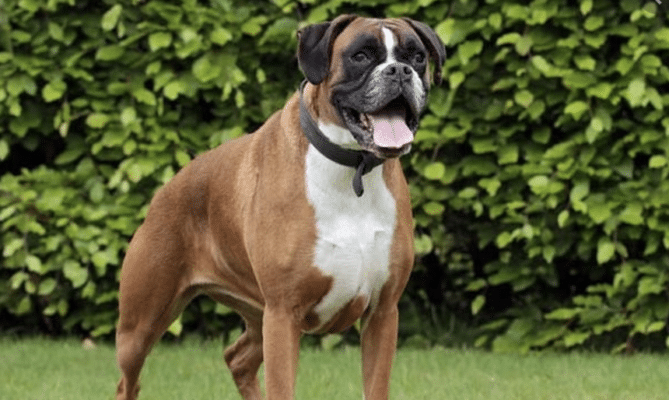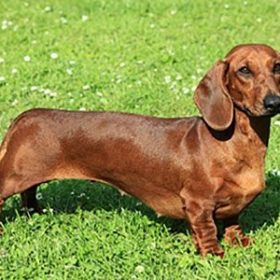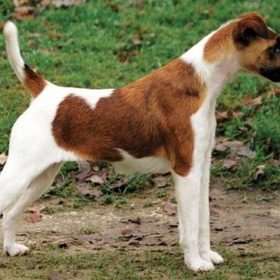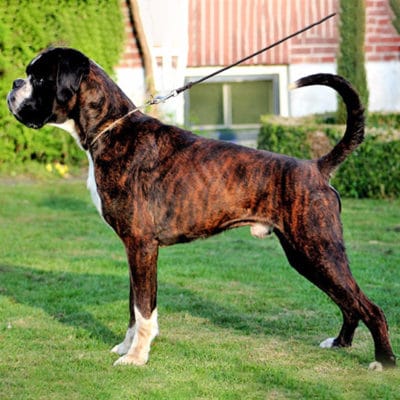Boxer

The Boxer’s peculiarity is that although he is partly a guard dog, he is a very playful dog. One of the reasons for this peculiarity is extended maturation. Full maturation does not occur before three years of age. He is called an “affectionate fidget,” because no family member will not go unnoticed. Just as it can not remain indifferent to the Boxer’s attempts to attract the owner’s attention with some fetching game.
Table of Contents
Breed Information
| Another Name | German Boxer, Deutscher Boxer |
| Origin | Germany |
| Height | Males 56-63 cm Females 53-60 cm |
| Weight | 24-34 kg |
| Fur | Short |
| Color | Red, tiger, white, tiger with white spots |
| Lifespan | 9-15 years |
| FCI Classification | Perros cobradores de caza – Perros levantadores de caza – Perros de agua |
| Group | Dogs for apartments, dogs for protection (guard dogs) |
| Price | From $450 |
Breed Photos
Origin History
One popular breed around the world is the German Boxer. The Boxer’s ancestors are Mastiffs, Bulldogs, and Bullenbeissers, through which a new species emerged by 1895.
Bullenbeissers were common in Western and Central Europe for a long time because they were considered versatile dogs. At that time, they were used as shepherds and for carrying loads and hunting wild boar and buffalo. Later, ancestral Boxers were used in guarding estates. They are excellent guards because they do their job with exceptional calm and consistency.
It is generally accepted that the pedigree of the Boxer begins at the end of the 19th century. The great-grandfather of the Boxer named Lechner was registered as Bierboxer or Modern Bullenbeiser. Later, his “daughter” mated with a male bulldog and gave birth to a new litter. It is how the Boxer breed was registered. It was then that the German Boxer was first officially introduced at the 1895 Senbernar show in Germany.
Popularity and distribution in America fell by 1903, and since 1925 in Germany, the Boxer is commonly referred to as a service breed. They were even mobilized in the German army to be used as sanitation, liaison, and guard dogs. Nowadays, German Boxers are often used as guide dogs and bodyguards.
Appearance
It is a short-haired, strong, and energetic dog. The Boxer has a pronounced square format. The body rests on strong straight legs. The body is well-proportioned, and the musculature is well-developed. The muzzle is robust and broad but short. The chest of these dogs is deep and voluminous. They can be red or tiger in color. Redhead may be of different shades: from yellow to red-brown. There may be white markings, which serve as a colorful decoration.
Character
The Boxer’s peculiarity is that although he is partly a guard dog, he is a very playful dog. One of the reasons for this peculiarity is extended maturation. Full maturation does not occur before three years of age. He is called an “affectionate fidget,” because no family member will not go unnoticed. Just as it can not remain indifferent to the Boxer’s attempts to attract the owner’s attention with some fetching game.
Keep in mind that the owner will have to protect the German Boxer from heat and cold. Because his coat and muzzle are short, he is extremely uncomfortable with temperature changes. The breed is considered a gentle creature that suffers from all kinds of weather conditions, which have health consequences for the dog. Get him some interesting winter coveralls or a raincoat to protect him from rain and snow so he does not get too cold. Not only will this save the pet from inflammation, but it will also give you positive emotions that you will get when you see this miracle in unique clothes.
Boxers get along well both in a private home and in an apartment. The only prerequisite: they do not like to be left alone, as these dogs have a high need for companionship and physical activity. If their conditions are ignored and left home alone, they can exhibit destructive behavior. This breed is ideal for those who prefer not to part with their pet or for large, noisy families whose home is seldom empty.
A Boxer’s anger level is low. This applies to strangers as well as other dogs. With strangers, the dog is cautious, balanced, but vigilant. Because of its dynamic nature, even the most spoiled and frisky child can easily find a common language with the German Boxer.
Care
Although the Boxer’s coat is short and smooth, the shedding rate is high. It is recommended to comb and bathe the dog once a week. After bathing, it is better to brush the dog with a soft brush with short teeth. It is better to wipe and clean the eyes and ears 3-4 times a week. Claws should be trimmed about three times a month.
Training
Training classes for the Boxer are better to start at an early age. The dog is endowed with good intellect, obedience, and memory, so training and training will go without problems. Boxer’s outgoing nature will help you quickly learn commands. You can’t discipline him because he’s more likely to ignore your actions. Praise and treats with your pet’s favorite treats may help. Be patient, creative, and, most importantly, in tune with him. Get him on your side, and you won’t need to wait long for results.
Common Diseases
The breed is prone to some diseases:
- dermatitis and allergic reactions;
- deafness (about 20-40% of white pups are born deaf. The disease can affect one or both ears at once);
- hypothyroidism;
- an inherited disorder: boxy cardiomyopathy (BCM). Also called Boxer arrhythmic cardiomyopathy (BAC), familial ventricular arrhythmia (FVA);
- corneal dystrophy;
- gastric torsion;
- aortic stenosis/subaortic stenosis (AS/SAS). It is one of the most common heart defects in German Boxers;
- Boxers are especially prone to developing lymphoma and brain tumors. Specimens with excessive white markings can tan in the sun and even develop skin cancer.
Nutrition
German Boxers are not picky about food. They will gladly eat whatever they see on the owner’s plate. That is why it is better to choose food seriously and responsibly. Do not allow the food in the diet that can harm the digestive system of the pet.
 Dachshund
Dachshund Small Swiss Hound
Small Swiss Hound Moscow Watchdog
Moscow Watchdog Havanese
Havanese Smooth Fox Terrier
Smooth Fox Terrier French Bulldog
French Bulldog


